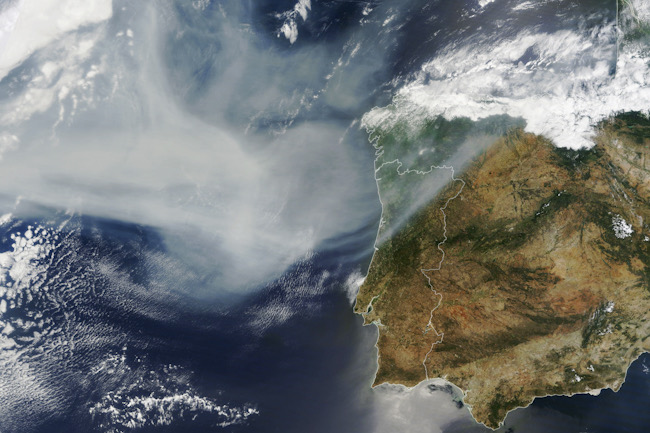After choking New York City and other major metropolises on the U.S. East Coast a few weeks ago, wildfire smoke from Canadian wildfires is now blanketing the Midwest — and streaming all the way across the Atlantic to Europe.
I got a first-hand look at the smoke while flying in and out of Chicago yesterday (June 27), where some of the worst air pollution levels among major world cities were recorded. (As was the case for Minneapolis and Detroit too.) Here’s a photo I took of the pall just after take off:
Smoke from wildfires blazing in Canada blanketed Chicago on Tuesday, June 27, 2023, as seen in this photo taken through the window of a United Airline flight departing from O’Hare International Airport. (Credit: © Tom Yulsman)
The blanket of smoke was frightfully evident once we reached cruise altitude at 37,000 feet:
A thick pall of smoke smothers the Midwest on June 27, 2023, as seen from the window of a United Airlines flight between Chicago and Buffalo, N.Y. (Credit: © Tom Yulsman)
Apparently, the smoke made an impression among people traveling aboard Air Force One. As a story in the N.Y. Times put it: “In Chicago, Air Force One descended through a thick layer of smoke and haze at the O’Hare International Airport late Wednesday morning, as President Biden arrived for a speech on the economy.”
Winds are now pushing the smoke toward New York City and other East Coast cities, where it is expected to cause worsening air quality.
A few days ago, prevailing winds blew the smoke across the Atlantic Ocean to Portugal and Spain:
On June 26, 2023, a plume of soot streamed eastward from North America across more than 2,000 miles of the Atlantic Ocean, approaching Europe. The map is based on modeling that assimilated observational data from satellites, aircraft, and ground-based observing systems. (Credit: NASA Earth Observatory)
On June 26, the wildfire smoke was so prominent that a camera aboard the Deep Space Climate Observatory, or DSCOVR, spacecraft was able to capture a clear image of it:
The Earth Polychromatic Imaging Camera, or EPIC, aboard the DSCOVR spacecraft acquired this image Earth from about 936,000 miles away on June 26, 2023. A magnified portion of the view shows wildfire smoke over the Atlantic and Portugal. (Credit: NASA)
According to the Canadian Interagency Wildfire Centre, 481 fires are burning in the country. Year to date, 2,987 fires have burned across 30,888 square miles — an area roughly equal to the State of Maine.
Greenhouse gas emissions have warmed Canada at a rate roughly twice the global average rate. Meanwhile, a 2018 study showed that large Canadian wildfires have been growing larger, and the fire season has been starting approximately one week earlier and ending one week later. This year, wildfires began particularly early in the province of Quebec, which has been experiencing dramatically warmer and drier conditions than normal.














